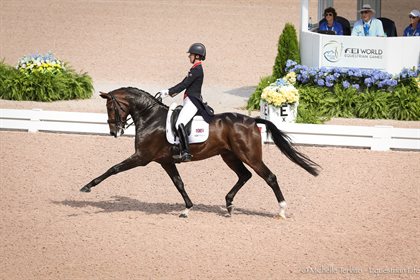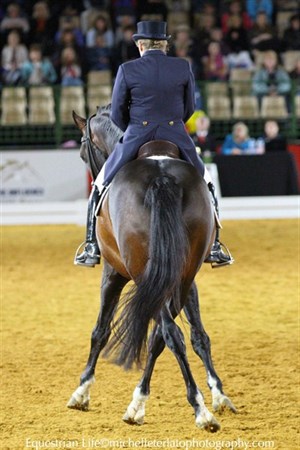
Charlotte Dujardin, pictured here riding Mount St John Freestyle, has an incredibly strong core. Our core muscles help to control our sitting trot.
© Michelle Terlato Photography
Master the sitting trot
By Dr Kerry Mack
Mastering the sitting trot can be one of the biggest challenges of progressing our riding. Many of us dread those movements in the dressage tests that specify sitting trot. So why should we bother?
The sitting trot isn’t just for appearances, actually. The higher the level of training we go, the more we need to be accurate with our aids. It is by correct application of the aids that we communicate with our horse. If we want to influence every step to be higher and more expressive, and if we want to be training for better balance and more collection, we need to be able to give very subtle and accurate aids.
I believe that horses read the aids we give unconsciously with our core muscles, our deep postural muscles that we control involuntarily, as well as the aids we give with our hands and legs, the aids that we are conscious of using. When we sit on the back of the horse with our seat bones stable, we can give these subtle aids to our horse.
So, there are a few fundamental things to understand about how we sit on a horse. We must not grip; we must balance. Our bodies must be still in relation to the horse, not still in relation to the ground. The back of the horse should be relaxed and supple, not rigid, so we must sit on the back of the horse with flexibility and suppleness. We must not grip onto the horse. If we try to grip on, our bodies will be stiff and rigid, and the movement of the horse’s back is likely to push us away from the horse.
Gripping on is therefore likely to make us bounce off the horse’s back and bang down on it again. This is uncomfortable for us and for our dancing partners. Our bodies should have a positive muscle tone, but not be stiff. We should be like putty, having enough tone to hold our own shape, (posture) but enough plasticity to keep a really stable, even contact with the horse’s back.
I like to teach riders to begin the sitting trot keeping an awareness of the correct diagonal. In the rising trot we rise as the outside shoulder and inside hind leg are moving forward. As we rise, our legs gently close around the ribs of the horse as we push down into our stirrups to rise up. So, our legs gently encourage the inside hind leg to step under. Our aids will be delivered as a rhythmical pulsing in time with the horse’s movement, not as a rigid, vice-like grip.
We want to still apply the aids in this rhythmical, pulsing way at sitting trot, still in the timing to encourage the inside hind leg to be quicker. A good way to start to get the feel for this is to start in rising trot, on the correct diagonal, of course, and then sit just for a few strides still feeling as if you are rising ever so imperceptibly. Then, before you lose the rhythm and feel for the diagonal, go back to rising. Try four steps rising, four steps sitting, four steps rising, four steps sitting.
Think of the sitting trot as if it is a tiny rising trot. You rise just enough that your seat bones are lighter in the saddle, but not enough that the seat bones come off the saddle. As you develop the feel for this, allow yourself to sit for a longer time. If you lose the feeling, you can get it back by rising for a few steps to reinforce the correct diagonal timing. It takes a while to get used to this, but eventually it can become automatic so that the half-halt is always applied in the correct timing.
For example, in the shoulder-in you want to time the aids to get the inside hind leg stepping up under the body of the horse so that as your seat lightens in time with the outside shoulder (and inside hind leg) moving forwards, your legs close around his ribs as they support the seat lightening. Same in the half-pass. It is harder to stay on the correct diagonal in the half-passes though, because it tends to be intuitive to lighten as the leading shoulder goes forward. But if you do that, you are influencing the outside hind leg, which is not correct.
In the half pass, you want your seat to lighten in time with the outside shoulder (and inside hind leg) moving forwards, and your leg should close around his ribs as they support the seat lightening.
© Michelle Terlato Photography
When you are aware of the diagonal even in the sitting trot, it becomes more natural to use the rhythm of the trot; increase the trot into medium or extended, and rebalance the trot into collected trot or passage. Step by step. You will use the reins less to make these transitions within the pace. The neck won’t get shorter as you shorten the strides. This encourages the horse to stay balanced and regular, and not surge forward or stall back. Later on, you can ask the horse to make higher steps and develop passage and piaffe and the transitions in between by sitting deeper into the rhythm in the same way.
You have not been told this before? I believe that the really talented riders, the ones with the amazing feel, do this automatically. However, they are not aware of it because the deep postural muscles involved are not consciously controlled.
I was lucky enough to ride in a masterclass for Kyra Kyrkland some years ago. She helped me greatly to improve the sitting trot. She suggests using some imagery to reorganise your body. Imagine your torso as two blocks — one mobile rubbery block from the waist down, topped by a solid heavy block more like stone from the waist up. From your waist down the nearly cubic block is quite mobile. Your seat bones sit either side of the horse’s spine, within this block. This block moves easily up and down with the horse’s back. Your pubic bone and pelvis are mobile and flexible enough to remain still in relation to the horse’s back. Imagine this rubbery, putty-like block from the waist down is pushed down onto the horse’s back by the more oblong block of your upper torso from the waist up. Include your head as part of this imaginary block. This block is very heavy. I tend to think of it like sandstone. The top block balances on the bottom block, maybe towards the back of the block, and pushes down and forwards onto the bottom block. The top block stops the bottom block from bouncing.
Open up your chest and shoulders to make this top block really narrow from front to back. Maybe try to point the bottom of your shoulder blades down into your pelvis, directing the weight of the top block down into the bottom block. As the horse trots, the bottom block moves with the horse’s back and the top block pushes down onto it, keeping it still.
Your legs hang down loosely from the bottom block. The big muscles on the back of your thigh sit like a cushion behind your leg. Of course, your leg doesn’t grip, it just hangs. Try to stretch the front of your thigh and the back of your calf down to gently stretch your leg underneath you, with a softly bent knee and a soft ankle (heels down).
When you get the hang of this you can play with it just for fun. Get the rhythm swinging, gently remaining on the correct diagonal at trot. Then stop the movement of your pelvis. Sit very still. You may find that the sitting still will work like a handbrake. Your rigid core muscles will restrain the elastic movement of the horse’s back. You may feel yourself being pushed off the back, just like you were when you were a beginner. The stiffer you make your body and the more you grip, the more you are likely to be pushed off the horse’s back. Of course, it will take practise. Remember, it takes 10,000 hours of practise of anything to become an expert! So get to it, and have fun.
READ THE LATEST NEWS ARTICLES HERE
https://www.equestrianlife.com.au/articles/Master-the-sitting-trot


